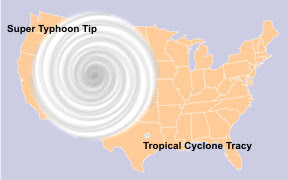Just kidding about the cat 6. Although some aficionados have suggested the addition of a designation above the current cat 5 (157 mph and up) there is no such thing yet.
First up the last bulletin from the National Hurricane Center, 11AM EDT:
...POWERFUL CATEGORY 5 LEE EXPECTED TO MAINTAIN ITS INTENSITY...

And from one of the hurricane bigwigs, Colorado State University's Phil Klotzbach
And finally a couple storms worthy of note. First, Hurricane Patricia on Mexico's Pacific coast in 2015:#Hurricane #Lee is forecast to reach a max intensity of 180 mph. Only seven Atlantic hurricanes in satellite era (since 1966) have had max winds >= 180 mph:
— Philip Klotzbach (@philklotzbach) September 8, 2023
Allen (1980), Gilbert (1988), Mitch (1998), Rita (2005), Wilma (2005), Irma (2017), Dorian (2019) pic.twitter.com/P5HOUDFMb3
- The National Hurricane Center Calls Patricia "THE STRONGEST EASTERN NORTH PACIFIC HURRICANE ON RECORD."
- "Stunning, historic, mind-blogging, and catastrophic: Hurricane Patrica Hits 200 mph"
- The Astonishingly Light Damage Caused By Hurricane Patricia
....Patricia the third strongest tropical cyclone in history (by wind)Patricia's 200 mph sustained winds make it the 3rd strongest tropical cyclone in world history (by 1-minute averaged wind speed.) Officially, here are the strongest tropical cyclones in world history, according to the Joint Typhoon Warning Center and the National Hurricane Center (using 1-minute averaged sustained winds):Super Typhoon Nancy (1961), 215 mph winds, 882 mb. Made landfall as a Cat 2 in Japan, killing 191 people.Super Typhoon Violet (1961), 205 mph winds, 886 mb pressure. Made landfall in Japan as a tropical storm, killing 2 people.Super Typhoon Ida (1958), 200 mph winds, 877 mb pressure. Made landfall as a Cat 1 in Japan, killing 1269 people.Super Typhoon Haiyan (2013), 195 mph winds, 895 mb pressure. Made landfall in the Philippines at peak strength.Super Typhoon Kit (1966), 195 mph winds, 880 mb. Did not make landfall.Super Typhoon Sally (1964), 195 mph winds, 895 mb. Made landfall as a Cat 4 in the Philippines.However, it is now recognized (Black 1992) that the maximum sustained winds estimated for typhoons during the 1940s to 1960s were too strong. The strongest reliably measured tropical cyclones were both 10 mph weaker than Patricia, with 190 mph winds—the Western Pacific's Super Typhoon Tip of 1979, and the Atlantic's Hurricane Allen of 1980....
Super Typhoon Tip is also notable for its size:
Those Pacific Ocean storms can get pretty big-
Here's 1979's Super Typhoon Tip:
About half the size of the contiguous United States.
And although it didn't make the sustained wind leaderboard in 1996 Severe Tropical Cyclone Olivia had a wind gust measured at 253mph, the world record non-tornadic wind speed.
